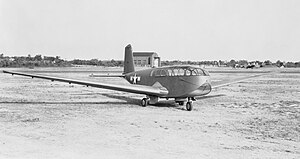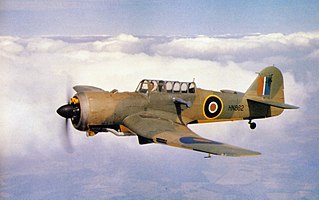
The Miles M.25 Martinet was a target tug aircraft of the Royal Air Force (RAF) and Fleet Air Arm (FAA) that was in service during the Second World War. It was the first British aircraft to be designed specifically for target towing.
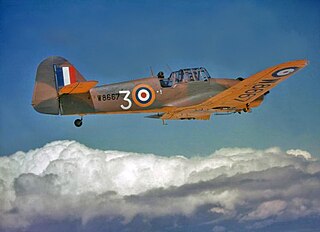
The Miles M.9 Master was a British two-seat monoplane advanced trainer designed and built by aviation company Miles Aircraft Ltd. It was inducted in large numbers into both the Royal Air Force (RAF) and Fleet Air Arm (FAA) during the Second World War.
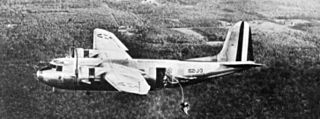
The Douglas DC-5 was a 16-to-22-seat, twin-engine propeller aircraft intended for shorter routes than the Douglas DC-3 or Douglas DC-4. By the time it entered commercial service in 1940, many airlines were canceling orders for aircraft. Consequently, only five civilian DC-5s were built. With the Douglas Aircraft Company already converting to World War II military production, the DC-5 was soon overtaken by world events, although a limited number of military variants were produced.

The Mizuno Shinryū/Jinryū was a late-World War II Japanese rocket-powered interceptor. While the Jinryū was still in development, Mizuno began to develop an interceptor which both the Army and Navy air force were in desperate need of to fend off the Boeing B-29 Superfortress. When Japan surrendered to the Allies on 15 August 1945, all aircraft that were under development were stopped, including the Jinryū & Shinryū II. The Shinryū II was the second aircraft developed in Japan to use a canard design, after the Kyushu J7W Shinden.

The Brewster SB2A Buccaneer was a single-engined mid-wing monoplane scout/bomber aircraft built by the Brewster Aeronautical Corporation for the Royal Air Force (RAF) and United States Navy between 1942 and 1944. It was also supplied to the United States Army Air Forces and United States Marine Corps. The Buccaneer was overweight and lacked maneuverability, and has been described as a "classic failure"; while designed as a scout bomber, none saw combat, although a number found use in noncombat roles.

The Curtiss SBC Helldiver was a two-seat scout bomber and dive bomber built by the Curtiss-Wright Corporation. It was the last military biplane procured by the United States Navy. Delivered in 1937, it became obsolete even before World War II and was kept well away from combat with Axis fighters.

The Naval Aircraft Factory SBN was a United States three-seat mid-wing monoplane scout bomber/torpedo aircraft designed by the Brewster Aeronautical Corporation and built under license by the Naval Aircraft Factory in Philadelphia, Pennsylvania. The landing gear was similar to that on the Brewster F2A Buffalo fighter aircraft. The SBN had non-folding wings with perforated flaps.
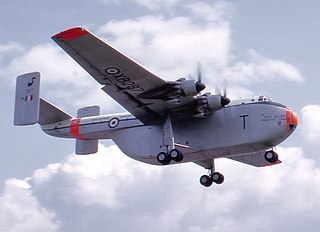
The Blackburn B-101 Beverley was a heavy transport aircraft produced by the British aircraft manufacturer Blackburn Aircraft. It was notably the only land-based transport airplane built by Blackburn, a company that otherwise specialised in producing naval fighter aircraft.

Military gliders have been used by the militaries of various countries for carrying troops and heavy equipment to a combat zone, mainly during the Second World War. These engineless aircraft were towed into the air and most of the way to their target by military transport planes, e.g., C-47 Skytrain or Dakota, or bombers relegated to secondary activities, e.g., Short Stirling. Most military gliders do not soar, although there were attempts to build military sailplanes as well, such as the DFS 228.

The Short Sturgeon was a planned British carrier-borne reconnaissance bomber whose development began during Second World War with the S.6/43 requirement for a high-performance torpedo bomber, which was later refined into the S.11/43 requirement which was won by the Sturgeon. With the end of the war in the Pacific production of the aircraft carriers from which the Sturgeon was intended to operate was suspended and the original reconnaissance bomber specification was cancelled.
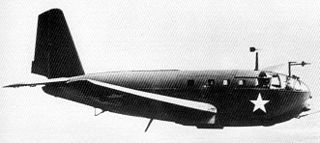
The Allied Aviation XLRA was a prototype flying-boat transport glider built for the US Navy during World War II. It was a low-wing wooden monoplane that could carry ten troops. Two prototypes were constructed, but orders for 100 production examples were cancelled when the Navy decided to opt for powered transport aircraft instead. The designation LR2A was assigned to a refined version of the design, but this was never produced.

The Douglas XCG-17 was an American assault glider, developed by the conversion of a C-47 Skytrain twin-engine transport during World War II. Although the XCG-17 was successfully tested, the requirement for such a large glider had passed, and no further examples of the type were built; one additional C-47, however, was converted in the field to glider configuration briefly during 1946 for evaluation, but was quickly reconverted to powered configuration.

The Schweizer SGS 2-8 is an American two-seat, mid-wing, strut-braced, training glider built by Schweizer Aircraft of Elmira, New York.

The Pratt-Read TG-32 was a 1940s American military training glider, designed and built by the Gould Aeronautical Division of the piano manufacturer Pratt, Read & Company of Deep River, Connecticut, for the United States Navy. The Pratt-Read glider was a monoplane glider having a fabric-covered steel tube fuselage and wooden wings and tail. The unique "polywog (tadpole)" shape was the suggestion of aerodynamicist Charles Townsend Ludington, former owner of the Ludington Line.

The Pratt-Read LBE-1 was a prototype glide bomb, or "Glomb", developed for the United States Navy during World War II. Although there were high hopes for the concept, the limitations of the Glomb led to the production contract for the LBE-1 being reduced, then cancelled, and only four examples of the type were ever built.

The Piper LBP was a glide bomb, or "Glomb", developed by Piper Aircraft for the United States Navy during World War II. Developed as one of three "Glomb" aircraft, the inherent limitations of the Glomb and the technology of the time, combined with difficulties encountered in testing of the prototype, led to the production contract for the LBP-1 being reduced, then cancelled, with none of the Glomb aircraft ever seeing operational service.

The Taylorcraft LBT was a glider designed and built by Taylorcraft during World War II, in response to a United States Navy requirement for a glide bomb. One of three prototype "Glomb" models ordered by the Navy, the LBT suffered from technical and performance difficulties, and was cancelled early in production, none of the aircraft seeing operational service.
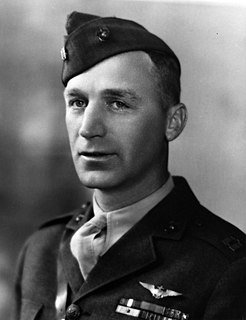
Vernon Melvin Guymon was a highly decorated mustang officer and naval aviator of the United States Marine Corps with the rank of brigadier general. A veteran of many conflicts, Guymon served as gunnery sergeant with 6th Marines during World War I, later commissioned and trained as naval aviator he distinguished himself during the combats in Nicaragua and received Navy Cross, the United States military's second-highest decoration awarded for valor in combat. During World War II, he served as commanding officer of Marine Glider Group 71 and Marine Aircraft Group 12 in the Pacific theater and retired as brigadier general in 1949.
